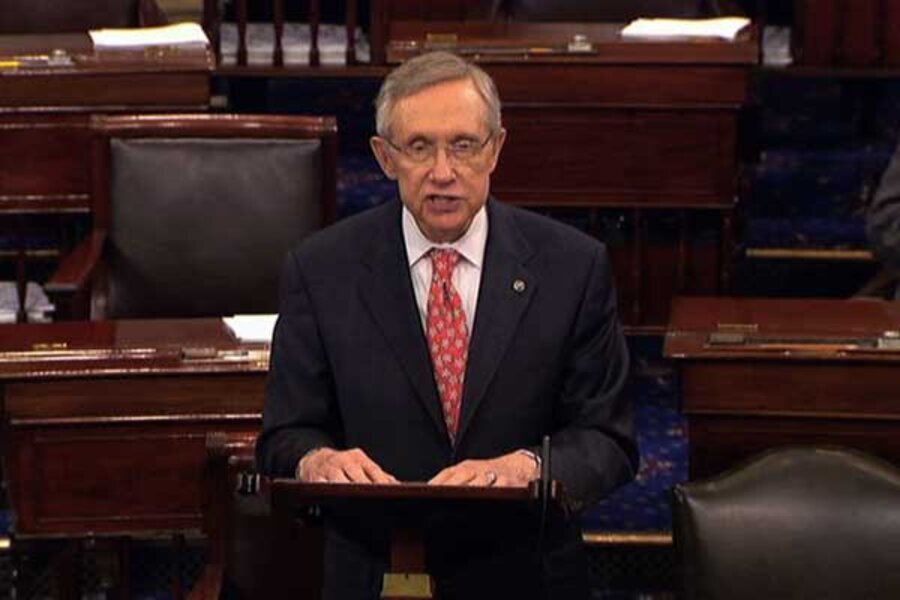Debt-ceiling compromise taking shape: What's in it?
Loading...
| Washington
After weeks of bitter words and punishing votes, congressional leaders are reporting progress toward a deal on the nation’s debt crisis, which is nearing its Aug. 2 deadline.
Senate majority leader Harry Reid (D) of Nevada on Saturday postponed a 1 a.m. vote on his own plan to resolve the crisis, saying more time was needed to work out the details.
“There are negotiations going on at the White House now on a solution that will avert the catastrophic default on the nation’s debt,” he said in a surprise late-night statement on the floor of the Senate. “There are many elements to be finalized ... but I believe we should give everyone as much room as possible to do their work."
While details of the negotiations are unconfirmed, aides close to the talks say that a tentative framework includes a plan by Senate minority leader Mitch McConnell (R) of Kentucky to allow President Obama to raise the debt limit on his own, barring a highly unlikely two-thirds vote in both houses of Congress to block him.
The plan would also include corresponding cuts – $1 trillion immediately, and then another $1.8 trillion to be identified by a bipartisan commission later this year. This second round of cuts would include a trigger mechanism to ensure that the cuts are actually implemented.
Republicans want to ensure that that trigger does not include tax increases, and Democrats do not want to see a trigger that mandates continual domestic program cuts. A compromise may involve cuts to defense spending.
First signs of a breakthrough surfaced when Senate minority leader Mitch McConnell (R) of Kentucky told the Senate on Saturday that private talks had resumed with the White House over how to resolve the crisis.
“The fact is the only way we’re going to get an agreement before Tuesday is to have it with the president of the United States,” said Senator McConnell.
It’s a sharp turnaround for the Republican leader, who had publicly announced on July 12 that “as long as this president is in the Oval Office, a real solution is unattainable.” McConnell did not participate in debt talks last week between the president and House Speaker John Boehner (R) of Ohio.
The breakthrough followed 48 hours of high political drama, as the Senate voted to table – in other words, refuse to consider – the latest House bill to resolve the crisis just minutes after it passed the House. House Republican leaders responded by defeating an earlier version Senator Reid's bill even before it was voted on in the Senate.
"It's all political theater, both what they did in the House and what we're doing on the floor of the Senate," said Sen. Johnny Isakson (R) of Georgia on Saturday. "But a lot is going on behind the scenes that is about substance and not just promises."
One of the sticking points during the months of trying to resolve the looming debt crisis has been GOP lawmakers' fears that they will accept a deal that promises spending cuts that subsequent Congresses fail to deliver – the fate of the Reagan tax hikes in 1982 and the Bush tax hikes in 1990.
Even if the White House and congressional leaders agree on a deal, the task of selling it to highly engaged rank-and-file members is a formidable one, on both sides of the aisle. A deal capable of mustering a bipartisan, 60-vote majority in the Democrat-controlled Senate must also clear a deeply divided GOP-controlled House.
Speaker Boehner has famously struggled to come up with a deal that will win even a majority within his own caucus. But he also appears unwilling to abandon even his most hardline conservatives. He began a divisive caucus meeting last week by telling members: "I just want you to know I love each and every one of you.... We've had deep divisions in our caucus, but we're all in this together," according to members at the closed meeting.
"Somewhere in between these two bills [Reid and Boehner], we're going to find a way," says Rep. Dave Camp (R) of Michigan.
Feelings are also running high on the Democratic side. Members fear that the emerging plan will not stand strong enough on core Democratic principles, such as requiring shared sacrifice from the richest Americans.
House Democratic leader "Nancy Pelosi says that the Boehner plan is the depths of hell and the Reid plan is purgatory,” says Rep. Jerrold Nadler (D) of New York. “I think that the Reid plan is the outer depths of hell, but still hell. But I voted for it to strengthen Reid’s hand so it doesn’t get worse, but it doesn’t mean I’ll vote for it in the end.”





